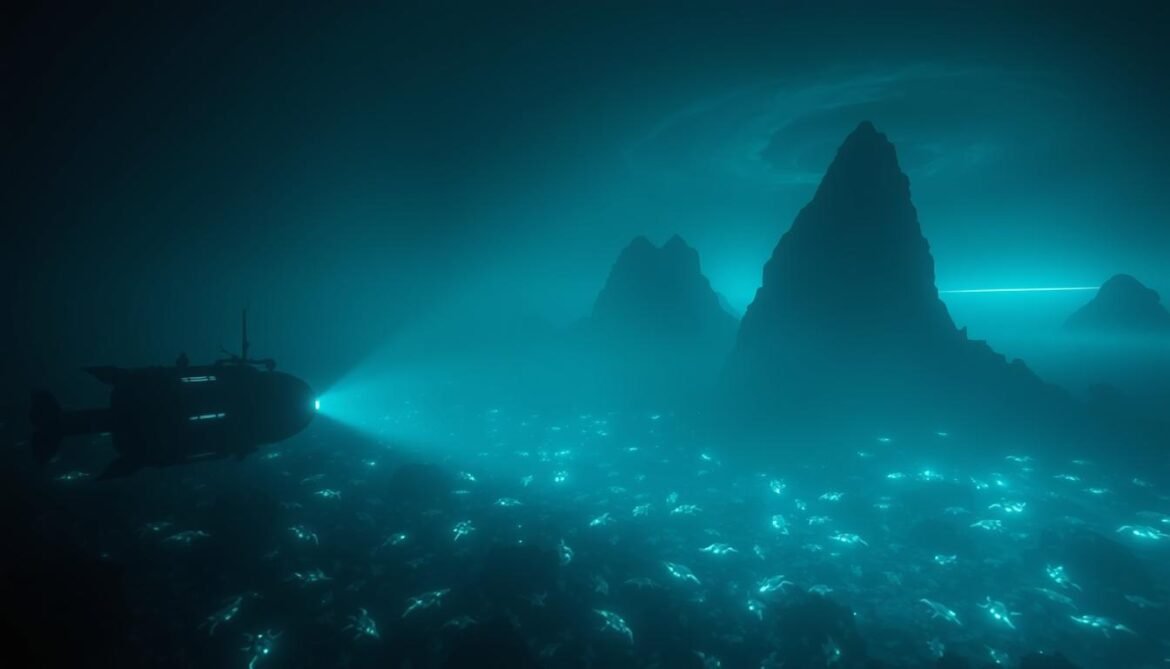Our world is mostly water. Seventy percent of Earth’s surface lies beneath the waves. Yet this vast aquatic realm remains one of our planet’s greatest mysteries.
Scientists have mapped more of Mars than our own seafloor. The darkest depths hold stories waiting to be told. They contain geological wonders and strange life forms.
Modern technology lets us explore further than ever before. Submersibles and remote vehicles peer into the abyss. Still, we’ve only scratched the surface of what lies below.
This journey will uncover documented discoveries and ongoing research. We’ll examine everything from hydrothermal vents to bioluminescent creatures. The deep remains Earth’s final frontier, full of secrets yet to be revealed.
Researchers worldwide continue their quest for knowledge. Each expedition brings new understanding of our blue planet. The mysteries of the deep continue to captivate science and imagination alike.
Introduction to the Ocean’s Mysteries
What lies beneath the surface of the water has sparked imagination for generations. This immense realm covers most of our planet, yet its darkest corners remain a profound puzzle.
The Allure of the Abyss
Human curiosity naturally draws us toward the unknown. The vast, dark waters represent the ultimate frontier, a place just beyond our reach.
This powerful allure has driven people to explore for centuries. They seek to understand the great mysteries hidden below.
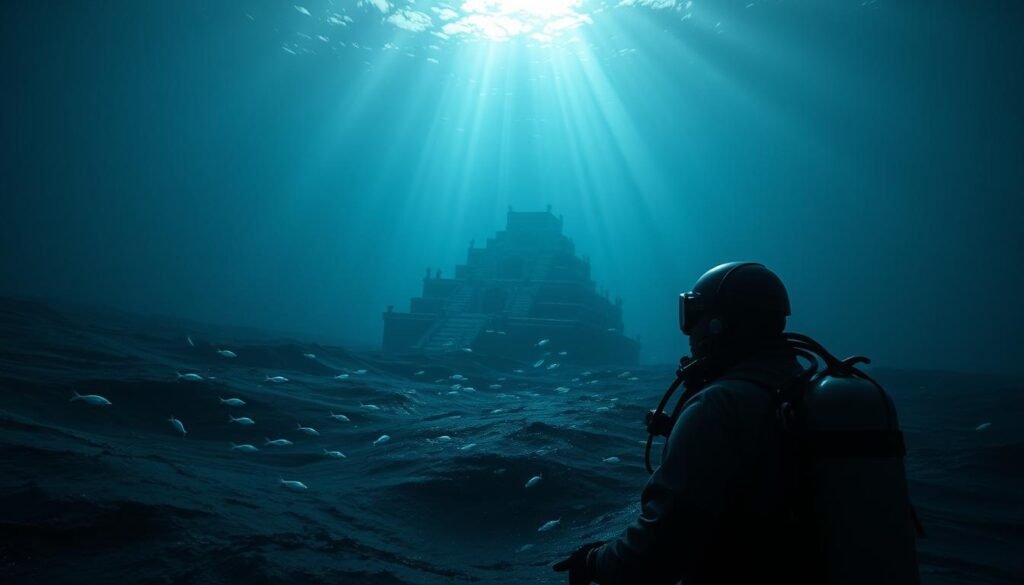
Historical Fascination with the Deep
Our fascination with the sea has a long history. Ancient sailors told tales of strange creatures and unexplained events.
For many years, technology limited our view. Stories of sea monsters fueled both fear and wonder about what was down there.
The 20th century brought a major shift. New tools like submersibles allowed direct observation, turning legend into science.
Despite this progress, vast areas are still unseen. The drive for exploration continues to captivate us today.
Exploring Deep Ocean Secrets
Scientific exploration of the sea’s most remote areas begins with understanding its distinct zones. These layers are defined by depth, pressure, and the absence of light.
Defining the Uncharted Depths
The journey into darkness starts around 650 feet below the surface. Here, sunlight can no longer penetrate.
This marks the beginning of the midnight zone. Further down lies the abyssal zone, stretching from 13,000 to 20,000 feet. It is one of the least explored places on our planet.
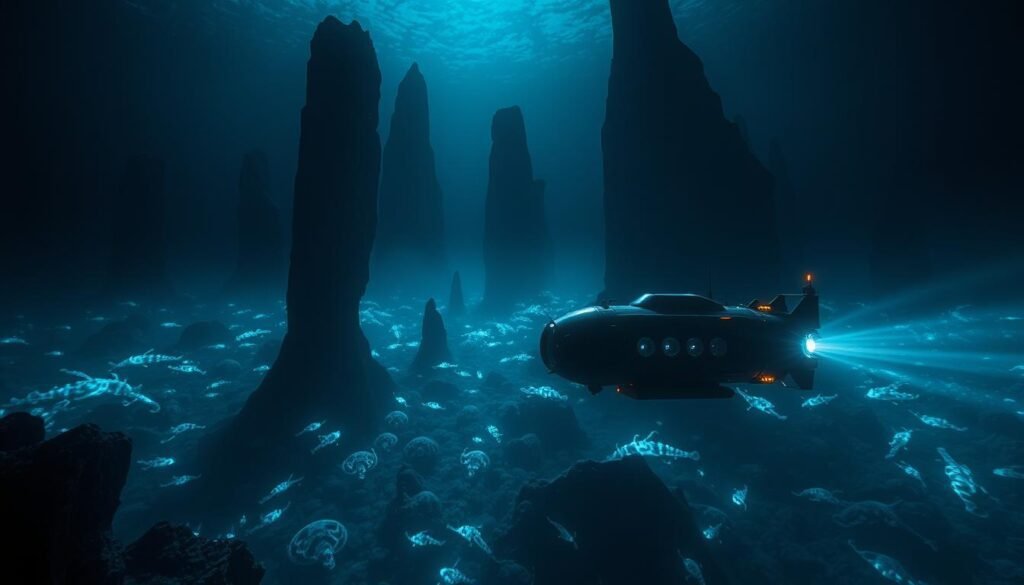
Despite having a rough map of the entire seafloor, the resolution is very poor. We can only see features larger than three miles across. Countless smaller wonders remain hidden from view.
Scientific Perspectives and Discoveries
For a long time, people thought these depths were barren wastelands. This perspective has completely changed.
Recent expeditions near Australia led to an amazing discovery. Scientists found hundreds of new species in the abyss. This includes the faceless fish, not seen since 1873.
Each new find raises more questions than it answers. Deep sea research is incredibly challenging due to extreme pressure and darkness. Initiatives like Seabed 2030 aim to bring this mysterious frontier into clearer focus.
Underwater Geological Wonders
The seafloor hosts geological phenomena that rival the most spectacular sights found on land. These incredible formations remain hidden from view, created by forces working in complete darkness.
Massive structures dot the underwater landscape, challenging our understanding of natural processes. The ocean floor contains mountains, vast plains, and mysterious rock arrangements.
Formation Phenomena and Rock Structures
Off the coast of Japan, the Yonaguni Monument features massive flat rocks with terraces and steps. Some researchers debate whether ancient civilizations shaped these formations.
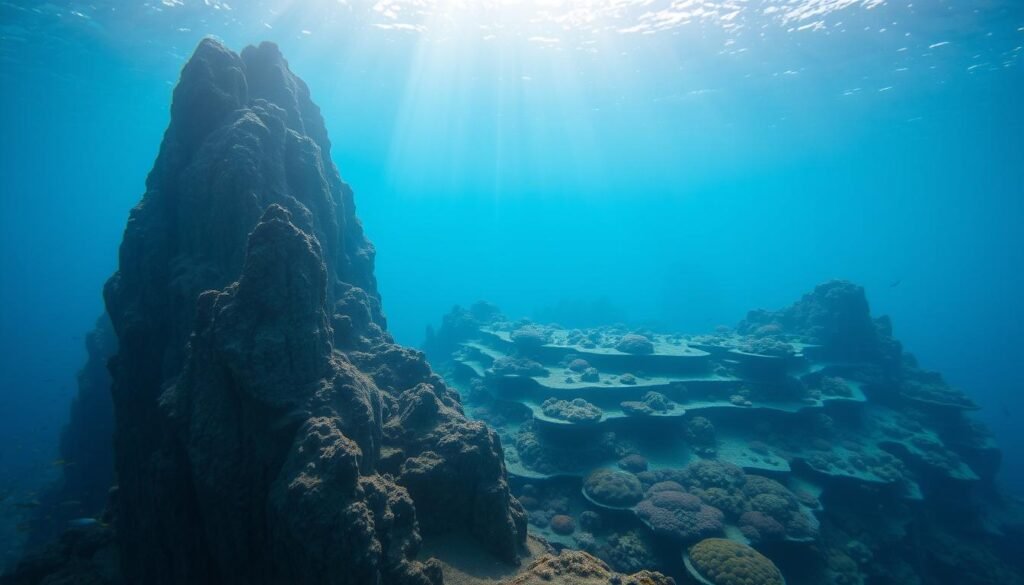
Most scientists attribute the structures to natural processes. Tectonic activity and underwater currents caused rocks to break apart over time.
Brine pools create extraordinary features on the ocean floor. Higher salt concentration forms distinct lake-like surfaces with visible shorelines.
Tectonic Activity and Natural Sculptures
The Denmark Strait contains Earth’s largest waterfall, where colder water plunges 11,500 feet. This massive drop in the ocean floor creates an incredible underwater cascade.
Other remarkable features include:
- Underwater volcanoes that create unique habitats
- Seamounts that influence ocean currents
- Cold seeps rich with methane-based ecosystems
These geological wonders demonstrate the dynamic nature of the seafloor. Tectonic forces and chemical processes continue to shape this hidden world.
Unseen Marine Creatures and Biodiversity
The darkest waters conceal biological wonders that defy conventional understanding of life’s limits. These hidden ecosystems support incredible biodiversity in places once thought barren.
Life in Extreme Conditions
Marine organisms survive where few could imagine. They endure crushing pressure, complete darkness, and near-freezing temperatures. These extreme conditions shape unique adaptations.
Hydrothermal vent communities demonstrate remarkable resilience. Discovered in 1977 near the Galápagos Islands, they host lush colonies of tube worms and clams. These species rely on chemosynthesis instead of photosynthesis.
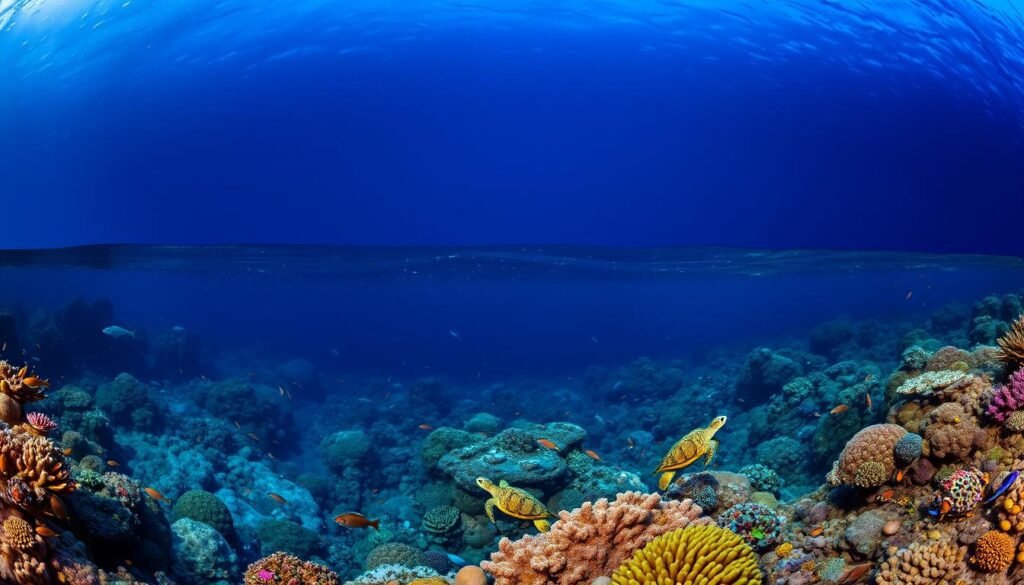
Vent organisms convert chemicals from superheated water into energy. This creates entire ecosystems independent of sunlight. The discovery fundamentally changed our view of where life can exist.
Unique Species from the Ocean Floor
Recent expeditions have revealed astonishing finds. A world-first DNA study shows how marine life connects globally. Scientists discovered hundreds of new species in the abyss near Australia.
The faceless fish reappeared after being unseen since 1873. Other finds include the spiny king crab and monkey brittle star. Each discovery raises questions about adaptation and evolution.
These creatures challenge biological assumptions. Their existence suggests similar life forms might thrive on other worlds. The ocean floor continues to surprise researchers with its hidden biodiversity.
Enigmatic Oceanic Phenomena
From glowing organisms to intricate seabed patterns, the aquatic realm continues to reveal astonishing visual mysteries. These phenomena challenge our understanding of marine biology and geology.
The Mysteries of Bioluminescence
Bioluminescence creates natural light shows in the dark waters. Certain organisms produce their own light through chemical reactions. This ability serves multiple purposes including attracting prey and communication.
The deep-sea jellyfish Aequorea victoria emits a stunning green glow. Researchers harnessed its bioluminescent protein for medical research. This discovery led to breakthroughs in live-cell imaging.
One remarkable phenomenon is the milky sea effect. Sailors reported this strange glow for centuries. In 2006, scientists captured a satellite image confirming the phenomenon. They discovered bioluminescent bacteria cause this massive light display.
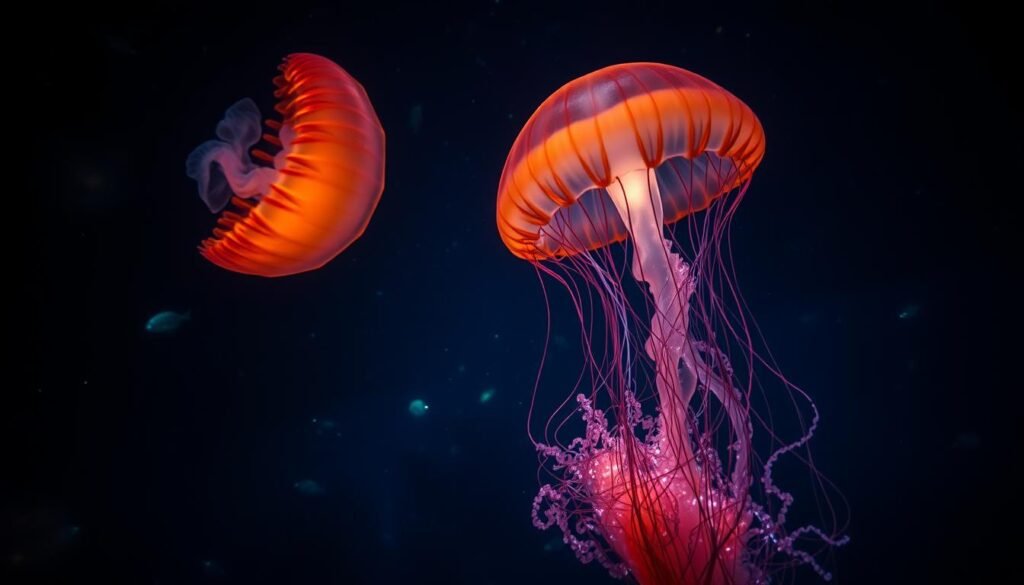
Curious Patterns and Underwater Crop Circles
Male pufferfish create intricate circular patterns on the seabed. They swim in precise patterns and flap their fins to construct these formations. These “underwater crop circles” serve as elaborate courtship displays.
Other circular patterns result from natural processes. Geological factors and ocean currents shape these formations. Sediment deposition creates mysterious designs on the seafloor.
These phenomena demonstrate nature’s creativity. They show how marine life and environmental forces interact. Each discovery brings new questions about our vast aquatic world.
Mariana Trench: The Deepest Frontier
Few places on Earth present greater challenges to exploration than the Mariana Trench. This massive chasm represents our planet’s ultimate depth, with the Challenger Deep reaching approximately 36,000 feet. That’s deeper than Mount Everest is tall.
Challenges of Extreme Depth and Pressure
The conditions in this trench are unlike anywhere else. Complete darkness envelops everything. Temperatures hover just above freezing.
The water pressure reaches eight tons per square inch. This immense force would crush most submarines. Only specially designed vessels can survive these extreme conditions.
Jacques Piccard and Don Walsh first reached the bottom in 1960. James Cameron completed a solo mission in 2012. Only three people have ever visited the deepest point.
Adaptations of Deep-Sea Life
Despite the harsh environment, life thrives in the Mariana Trench. Scientists have discovered remarkable creatures adapted to survive. These include unique species like the snailfish.
Organisms develop special proteins to prevent cellular collapse. Their bodies withstand pressure that would destroy surface animals. These adaptations show life’s incredible resilience.
Recent expeditions continue revealing new species. Each discovery teaches us more about survival in extreme conditions. The trench remains one of Earth’s least explored frontiers.
Intriguing Anomalies: From Bermuda Triangle to Devil’s Sea
The sea has long hosted stories of strange disappearances that challenge rational explanation. Two regions in particular have captured global attention for their reputed mysteries.
These areas continue to fascinate people despite scientific explanations. The legends surrounding them persist in popular culture.
Legends Versus Natural Explanations
The Devil’s Sea, near Japan’s coast, shares similarities with the Bermuda Triangle. Both have stories of vanished ships and aircraft.
People once attributed these events to supernatural forces. Modern science offers more plausible explanations for these maritime mysteries.
Researchers have systematically studied both regions. They found no evidence supporting paranormal theories about these water anomalies.
Navigational Challenges and Environmental Factors
Natural conditions create genuine hazards in these areas. The Bermuda Triangle experiences sudden weather changes.
Key navigational challenges include:
- Unpredictable ocean currents that disrupt travel
- Rapidly forming storms that catch vessels unprepared
- Cold water mirages that distort visual perception
- Seismic activity in tectonically active zones
Cold water mirages occur when temperature differences bend light. This creates optical illusions that can confuse experienced navigators.
Statistical analysis shows disappearance rates match other busy sea routes. The mystery persists because dramatic stories capture public imagination more than dry statistics.
Modern Technologies Unveiling Underwater Secrets
Revolutionary tools and systems now enable unprecedented access to the most remote aquatic territories. These innovations have transformed marine research in recent years.
Advancements in Submersibles and ROVs
Pressure-resistant submersibles allow direct observation at extreme depths. Remotely operated vehicles (ROVs) provide extended mission capabilities without human risk.
Autonomous underwater vehicles (AUVs) follow programmed routes independently. They collect data across vast areas of the seafloor.
In 2016, Ocean Exploration Trust researchers made a remarkable find. Their ROV captured a strange purple orb off California’s coast.
High-Resolution Sonar and Mapping Techniques
Advanced sonar systems create detailed three-dimensional maps of underwater topography. These technologies reveal hidden geological formations.
Scientists can now study marine ecosystems with incredible precision. High-resolution imaging captures minute details of aquatic life.
Mapping technology continues to improve over time. Each advancement brings new understanding of our planet’s submerged landscapes.
Scientific Discoveries and Ongoing Research
Global research initiatives are uncovering remarkable phenomena that challenge conventional scientific wisdom. International teams of scientists work together to solve complex marine mysteries.
Global Collaborative Efforts
The Sargasso Sea demonstrates how collaboration advances knowledge. This unique body of water is surrounded by currents instead of land. Researchers study its floating seaweed mats and distinctive marine life.
Teams from multiple nations share resources and expertise. This cooperation accelerates the pace of discovery in marine science. Each finding raises new questions for further investigation.
Breakthroughs in Marine Biology
The immortal jellyfish represents a major biological breakthrough. This tiny creature can revert to its juvenile form when threatened. Scientists discovered this ability in the 1980s, though the species was known for a century.
The Baltic Sea Anomaly continues to puzzle researchers. Discovered in 2011, this oval-shaped object has unusual characteristics. Most scientists favor natural explanations for such formations.
Current research focuses on understanding how marine organisms adapt. These studies could reveal insights about cellular regeneration. The time invested in marine exploration yields valuable knowledge about life processes.
Impacts of Deep Ocean Exploration on Science and Society
The exploration of Earth’s aquatic realms has fundamentally reshaped our understanding of planetary systems. Discoveries from beneath the waves influence everything from climate science to space exploration.
Studies of marine environments have contributed to theories about water’s origin. Some scientists suggest comets delivered water during Earth’s formation. Others believe volcanic activity released water vapor that formed our oceans.
Environmental Conservation and Policy
Research reveals how vulnerable these ecosystems are to human activity. Each dive provides evidence of pollution reaching even the most remote areas.
This knowledge drives important policy discussions about marine protection. International agreements now consider deep-sea mining and fishing regulations.
Scientists studying the “Earth’s hum” have made remarkable connections. This persistent vibration between 2-7 millihertz comes from waves interacting with the seafloor. It shows how ocean currents generate seismic waves through our entire planet.
These findings raise critical questions about conservation responsibility. They demonstrate that no part of Earth’s surface remains untouched.
Conclusion
The giant squid’s elusive nature demonstrates how much we still don’t know about marine life. This creature, potentially inspiring legendary sea monsters like the kraken, wasn’t photographed alive until 2004. Underwater video footage only became possible in 2012.
Scientists have learned very little about these deep-sea giants over time. They don’t even know their maximum size, though estimates suggest 66 feet. The colossal squid, reaching 45 feet, remains even more mysterious.
Researchers filmed a baby colossal squid for the first time in 2025. The adult form continues to be one of the sea’s great mysteries. Similarly, the giant oarfish lives at 3,300 feet and is rarely seen alive.
When two dead oarfish washed ashore in 2013, scientists questioned if environmental conditions played a role. Each new image and discovery reveals how many secrets remain. The ocean floor continues to yield new formations and organisms with every dive.
These enduring mysteries ensure researchers will explore for years to come. Our oceans hold countless secrets waiting for future generations to uncover.

